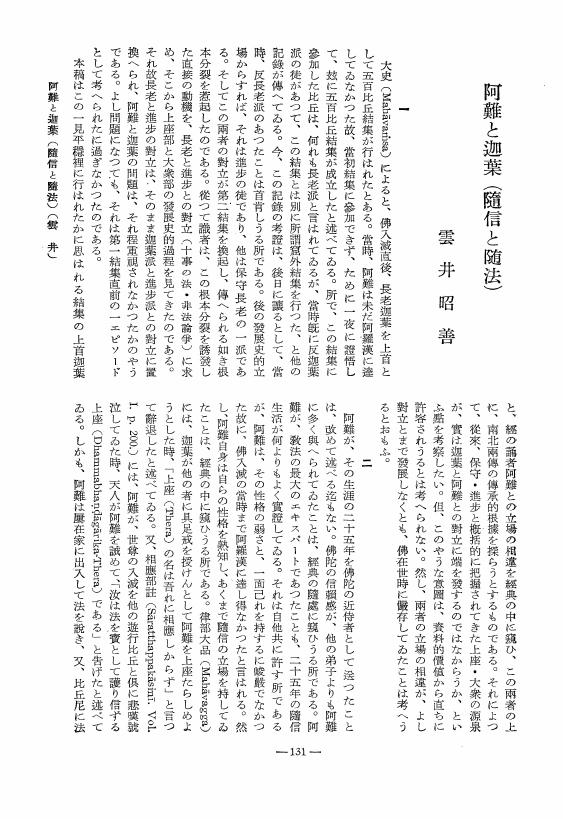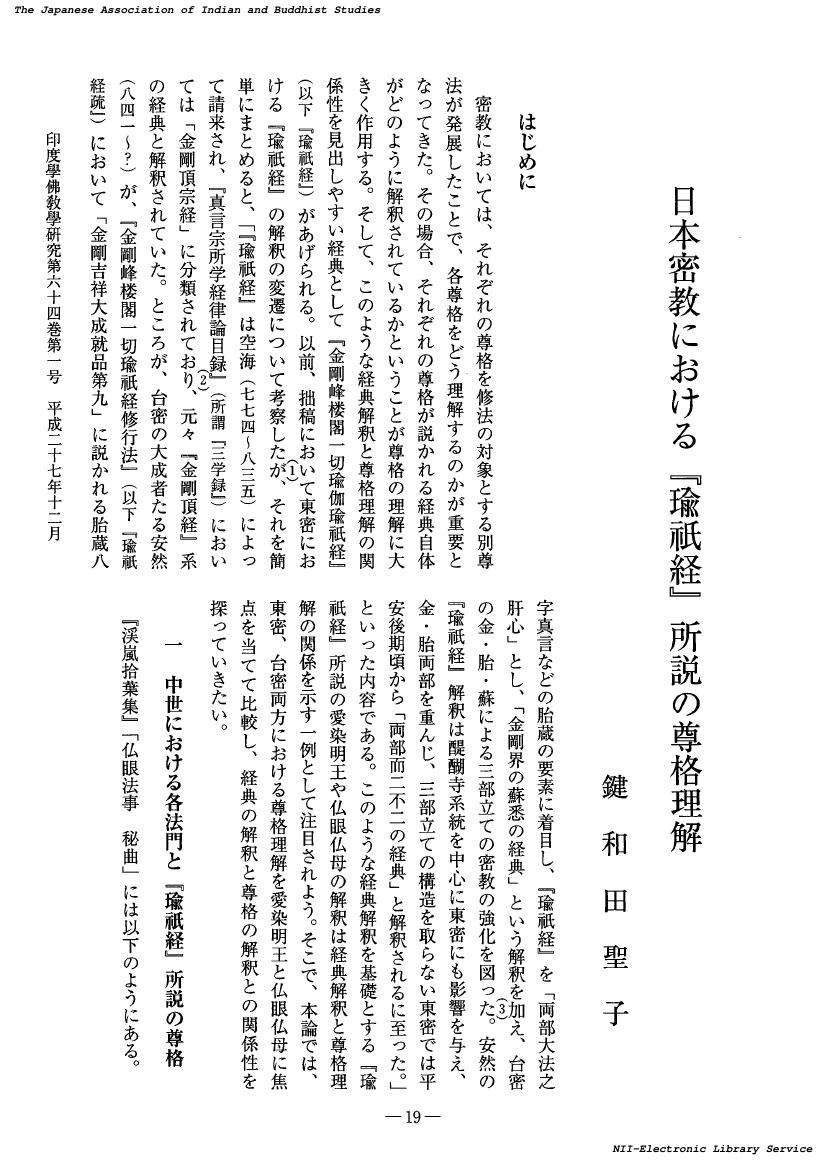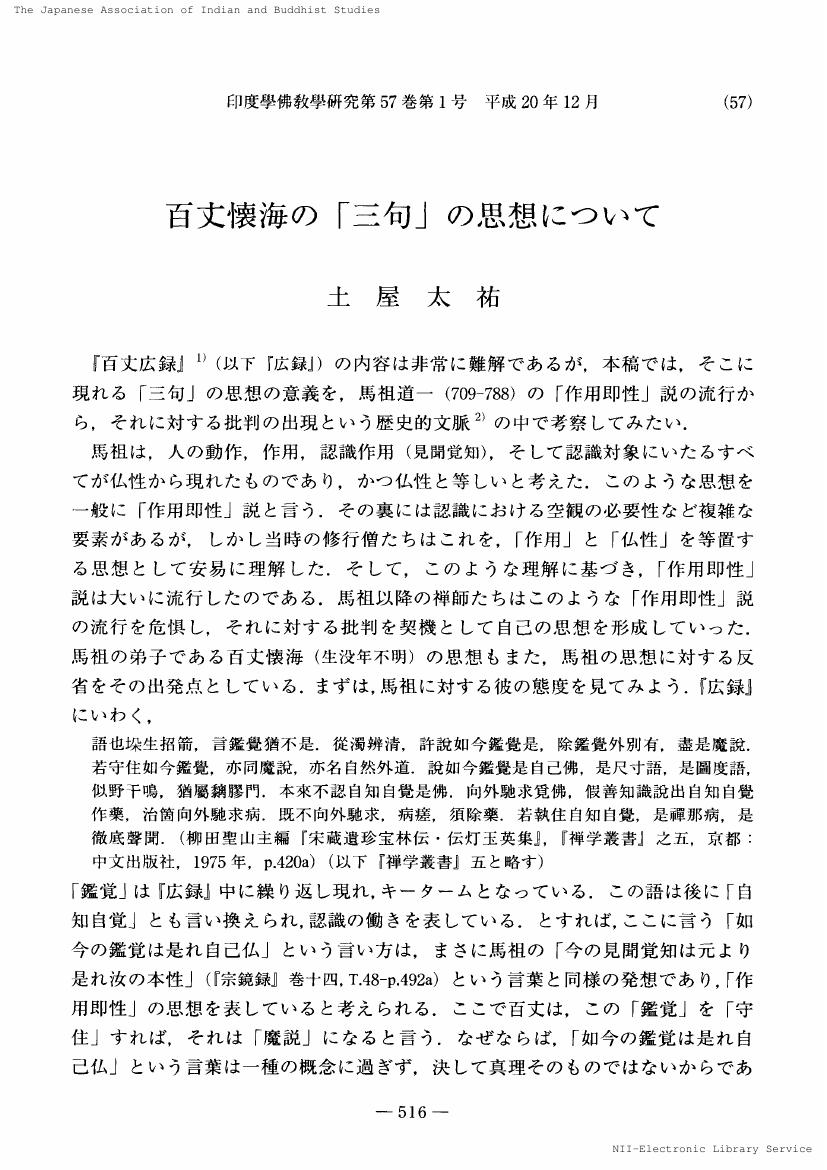1 0 0 0 OA インドラへの懐疑と信 ―― RV II 12,5 ――
- 著者
- 堂山 英次郎
- 出版者
- 日本印度学仏教学会
- 雑誌
- 印度學佛教學研究 (ISSN:00194344)
- 巻号頁・発行日
- vol.64, no.2, pp.782-775, 2016-03-20 (Released:2017-09-01)
1 0 0 0 ブルーノ・ペッツオルトと富永半次郎の比較文化研究
- 著者
- 小谷 幸雄
- 出版者
- 日本印度学仏教学会
- 雑誌
- 印度學佛教學研究 (ISSN:00194344)
- 巻号頁・発行日
- vol.59, no.3, pp.1281-1284, 2011
標記の題目で,一昨年度・昨年度と廿世紀の二十〜五十年代に東京およびその周邊で従事した兩人物の比較文化研究を紹介・論述した.一方はドイツ観念論哲學を重んじる天台宗の僧侶として忠實に傅統解釋を祖述する立場で,他方は一介の粋人・求道者として自由に釋尊の五蘊正觀を奉じる立場から,共に印度・シナ・日本三國の佛教とゲーテの全生涯に及ぶ種々のテーマとの比較-但しゲーテ自身は歴史上の佛教には言及がなく,専ら兩者の精神内容の比較-を試みた.前者が「説一切有部」の無明-行と「初めにロゴスありき」のファウストの盲目意志,大乗佛教とゲーテを結ぶ萬有内在神論に着目しながら,ゲーテの相對的一元性はヘーゲル,シェリング,さらには空假中の天台の絶對一元論の前段階とする高昇至上的な形而上學を堅持する.他方,富永はゲーテの形態學的発生史の発想で梵本原典から「根本法華(甲斐蓮華展方・梵和對譯)」を取り出しながら,昭和十二年初夏より釋尊末語のvayadhamma samkharaを念稱,其のあって,戦後『正覺に就いて』でガヤー正覺の,『釋迦佛陀本紀』で最晩年のチャーパーラー正覺の心理過程を文學的に創作した.ゲーテ最晩年の一年半の不安と『ファウスト第二部』の行詰りを「ある神秘的な心理學的轉換」で打開,その経緯を『釋迦佛陀本紀余論』に記す.それこそ最高度の佛陀現象で,釋迦のayu-samkharo ossattho(永壽追求の我執が既喝した)がメフィストフェレスの「この馬鹿さは容易なもンぢゃない」に比定される下りで,この詩人ゲーテ最深の心境は,アリストテレス如き散文的徒輩なら「狂気の沙汰」と見做すだらうと,自らW.v.フムボルトに書き送った底のものである.
1 0 0 0 OA 中國佛教における報恩思想とその實踐
- 著者
- 道端 良秀
- 出版者
- Japanese Association of Indian and Buddhist Studies
- 雑誌
- 印度學佛教學研究 (ISSN:00194344)
- 巻号頁・発行日
- vol.7, no.1, pp.270-273, 1958-12-01 (Released:2010-03-09)
- 被引用文献数
- 1
1 0 0 0 OA 華厳における「十義門」説について-特に法蔵を中心として-
- 著者
- 池 要
- 出版者
- Japanese Association of Indian and Buddhist Studies
- 雑誌
- 印度學佛教學研究 (ISSN:00194344)
- 巻号頁・発行日
- vol.37, no.1, pp.126-128, 1988-12-15 (Released:2010-03-09)
1 0 0 0 OA スリランカの大乗仏教について
- 著者
- 森 祖道
- 出版者
- Japanese Association of Indian and Buddhist Studies
- 雑誌
- 印度學佛教學研究 (ISSN:00194344)
- 巻号頁・発行日
- vol.38, no.1, pp.425-420, 1989-12-20 (Released:2010-03-09)
- 著者
- 伊藤 宏見
- 出版者
- 日本印度学仏教学会
- 雑誌
- 印度學佛教學研究 (ISSN:00194344)
- 巻号頁・発行日
- vol.19, no.2, pp.679-682, 1971
1 0 0 0 日本禅林の坐禅修行 : 定坐と摂心
- 著者
- 小川 太龍
- 出版者
- 日本印度学仏教学会
- 雑誌
- 印度學佛教學研究 (ISSN:00194344)
- 巻号頁・発行日
- vol.69, no.2, pp.608-615, 2021-03
1 0 0 0 OA <根本法華>のシンボリズム(二) : 虚空會における生中心のドラマ(一)
- 著者
- 小谷 幸雄
- 出版者
- 日本印度学仏教学会
- 雑誌
- 印度學佛教學研究 (ISSN:00194344)
- 巻号頁・発行日
- vol.55, no.3, pp.1176-1182, 2007-03-25
本學曾・2002年度(於・ソウル)で發表者は,"The Symbolism of Hokke-Proper:Morphological Studies on Saddharma Pundarika Sutra by a Private Scholar"と題して民間學者・富永半次郎の,『蓮華展方--原述作者の法華經』(梵和對譯,大野達之助・千谷七郎・風間敏夫他編1952)で完成を見た「根本法華」Hokke-Properの成立事情,その源流,即ちCh.ウパニシャッド・ラーマーヤナ・數論哲學・僧伽分裂史・阿育王碑文と,一貫したドラマとしての文脈を紹介略説した.それは西紀前一世紀頃の無名の一比丘の作と目され,現行廿八品中,序・方便・見寳塔・(勸持)・涌出・壽量・囑累の諸品(それらも全部は採用されず)を除いて他は後世の添加挿入として削除され,その發想源にゲーテ流の形態學が適用される.今回は,この發表に先立つ二ヶ月前に為した口頭發表(國際法華經學會,於マールブルク大2002年5月)の原稿に加筆,訂正したものである.霊鷲山の説法の座で無量義處三昧から釋迦は立ち,佛智の深甚無量,方便を説くと舎利弗がその所以を三請する.「佛陀とは何か」の疑問が一會から起きるや,突如一會の眞中から高さ〈五〉百由旬の塔が涌出,「正法巻舒」(←阿育王法勅)+〈白蓮華〉(←ウパニシャッド)の合成語が善哉と讚へられるシャブダ(權威ある言)として發せられる.その中を見たいとの恵光菩薩の懇願で,十方分身が還集一處する.釋迦が中空に上り,右手もて二片(對立概念)を撤去して入塔,涅槃佛(多寳如來)と半座を分つ.佛威徳を以て一會が中空に上げられると,釋迦が自分の涅槃後に「誰が正法を付囑し得るか」との問に一會の代表と他方來の菩薩が名乘をあげる.「止善男子」の一喝と共に,地皆震裂,大地から六萬ボディサットヴァ(=〈覺〉の本質,六萬←六十タントラの千倍,サーンキヤ哲學とサガラ王神話の六萬王子の換骨奪胎)が涌出,透明のアーカーシャに包まれ一會は〈五〉十中劫一少時,黙念.壽量品の〈五〉百塵鮎劫と共に〈五〉は五蘊--その軸が〈行〉蘊--の象徴.rddhyabhisamskara(サンスカーラの完成)が鍵語.因みに副題の〈生中心〉とは〈ロゴス中心〉(意識・概念偏重)の反對で,有機的全一の在り方を表すL.クラーゲスの用語.(富永師は,天台學會の招聘により奇しくも本・大正大學の講堂(昭和12年10月14日)で「私の観たる法華經」を講演された.『一』誌・特輯 第七號 法華精要富永先生の會 昭和13年2月20日)
1 0 0 0 OA 阿難と迦葉 (隨信と随法)
- 著者
- 雲井 昭善
- 出版者
- Japanese Association of Indian and Buddhist Studies
- 雑誌
- 印度學佛教學研究 (ISSN:00194344)
- 巻号頁・発行日
- vol.2, no.1, pp.131-132, 1953-09-30 (Released:2010-03-09)
1 0 0 0 バーチャル巡礼:――法然上人二十五霊場巡拝の一形態――
- 著者
- 山本 博子
- 出版者
- 日本印度学仏教学会
- 雑誌
- 印度學佛教學研究 (ISSN:00194344)
- 巻号頁・発行日
- vol.58, no.1, pp.154-158, 2009
1 0 0 0 OA 日本密教における『瑜祇経』所説の尊格理解
- 著者
- 鍵和田 聖子
- 出版者
- 日本印度学仏教学会
- 雑誌
- 印度學佛教學研究 (ISSN:00194344)
- 巻号頁・発行日
- vol.64, no.1, pp.19-24, 2015-12-20 (Released:2017-09-01)
1 0 0 0 OA 百丈懐海の「三句」の思想について
- 著者
- 土屋 太祐
- 出版者
- 日本印度学仏教学会
- 雑誌
- 印度學佛教學研究 (ISSN:00194344)
- 巻号頁・発行日
- vol.57, no.1, pp.516-513, 2008-12-20 (Released:2017-09-01)
1 0 0 0 OA 雀の比喩と無記説 -『倶舎論』「破我品」の所説に関して-
- 著者
- 石見 明子
- 出版者
- Japanese Association of Indian and Buddhist Studies
- 雑誌
- 印度學佛教學研究 (ISSN:00194344)
- 巻号頁・発行日
- vol.55, no.1, pp.399-396,1222, 2006-12-20 (Released:2010-07-01)
“The parable of the sparrow” is indicated by the word “nirgrantha-srava-ka-cataka-vat” in the ninth chapter of the Abhidharmakosa-bhasya (AKBh). The commentary on this word by Yasomitra forms one story that contains a question and an answer. It is similar to one of Aesop's Fables called “κακοπραγμον”which means “an evil doer.” This seems not have been identified among the Buddhist canons. The interpretation of “avyakrta” in this chapter is examined by referring to this story.In this story, the evil doer is a questioner. The section that includes the word in the AKBh discusses “avyakrta.” The Buddha is reported to have not expressed an opinion on a series of questions such as “Is the world eternal ” Relying on this, the Vatsiputriyas insist on “avaktavya.” They don't state whether an individual (pudgala) is exactly the same as elements (skandha).The point of the critique by Vasubandhu (the author of AKBh) is taking “prastur asaya” (the intentio n of the questioner) as the reason for “avyakrta”. Therefore, if a questioner does not have “asaya,” those questions should be answered. The parable of the sparrow is quoted to emphasize “asaya.”
1 0 0 0 OA 蓮華三昧経の成立をめぐつて
- 著者
- 水上 文義
- 出版者
- Japanese Association of Indian and Buddhist Studies
- 雑誌
- 印度學佛教學研究 (ISSN:00194344)
- 巻号頁・発行日
- vol.28, no.1, pp.164-165, 1979-12-31 (Released:2010-03-09)
- 被引用文献数
- 1 1
1 0 0 0 『改邪鈔』と伝覚如「十三箇条制禁」-倫理観を中心として-
- 著者
- 菊藤 明道
- 出版者
- 日本印度学仏教学会
- 雑誌
- 印度學佛教學研究 (ISSN:00194344)
- 巻号頁・発行日
- vol.45, no.2, pp.597-603, 1997
1 0 0 0 OA のろんじ考 -呪禁師のながれ-
- 著者
- 岩佐 貫三
- 出版者
- Japanese Association of Indian and Buddhist Studies
- 雑誌
- 印度學佛教學研究 (ISSN:00194344)
- 巻号頁・発行日
- vol.24, no.1, pp.414-417, 1975-12-25 (Released:2010-03-09)
- 参考文献数
- 10
1 0 0 0 京都本法寺の「楽座制度」について
- 著者
- 糸久 宝賢
- 出版者
- 日本印度学仏教学会
- 雑誌
- 印度學佛教學研究 (ISSN:00194344)
- 巻号頁・発行日
- vol.39, no.2, pp.748-752, 1991
1 0 0 0 OA 雲英晃耀の因明学
- 著者
- 師 茂樹
- 出版者
- Japanese Association of Indian and Buddhist Studies
- 雑誌
- 印度學佛教學研究 (ISSN:00194344)
- 巻号頁・発行日
- vol.63, no.3, pp.1126-1132, 2015-03-25 (Released:2017-09-01)
雲英晃耀(きら・こうよう,1831-1910)は,幕末から明治時代にかけて活躍した浄土真宗大谷派の僧侶で,キリスト教を批判した『護法総論』(1869)の著者として,また因明の研究者・教育者として知られる.特にその因明学については,『因明入正理論疏方隅録』のような註釈書だけでなく,『因明初歩』『因明大意』などの入門書が知られているが,その内容についてはこれまでほとんど研究されてこなかった.雲英晃耀の因明学については,いくつかの特徴が見られる.一つは実践的,応用的な面である.雲英は国会開設の詔(1881)以来,因明の入門書等を多数出版しているが,そのなかで共和制(反天皇制)批判などの例をあげながら因明を解説している.また,議会や裁判所などで因明が活用できるという信念から因明学協会を設立し,政治家や法曹関係者への普及活動を積極的に行った.もう一つは,西洋の論理学(当時はJ. S. ミルの『論理学体系』)をふまえた因明の再解釈である.雲英は,演繹法・帰納法と因明とを比較しながら,西洋論理学には悟他がないこと,演繹法・帰納法は因明の一部にすぎないことなどを論じ,西洋論理学に比して因明がいかに勝れているかを繰り返し主張していた.そして,三段論法に合わせる形で三支作法の順序を変えるなどの提案(新々因明)を行った.この提案は西洋論理学の研究者である大西祝や,弟子の村上専精から批判されることになる.雲英による因明の普及は失敗したものの,因明を仏教から独立させようとした点,演繹法・帰納法との比較など,後の因明学・仏教論理学研究に大きな影響を与える部分もあったと考えられる.
1 0 0 0 OA 大日如來表現形式の研究
- 著者
- 齋藤 彦松
- 出版者
- Japanese Association of Indian and Buddhist Studies
- 雑誌
- 印度學佛教學研究 (ISSN:00194344)
- 巻号頁・発行日
- vol.12, no.2, pp.576-582, 1964-03-31 (Released:2010-03-09)
1 0 0 0 OA 『菩薩地』における「余れるもの」
- 著者
- 本村 耐樹
- 出版者
- 日本印度学仏教学会
- 雑誌
- 印度學佛教學研究 (ISSN:00194344)
- 巻号頁・発行日
- vol.65, no.1, pp.353-348, 2016-12-20 (Released:2017-10-17)
- 参考文献数
- 6
In the Madhyāntavibhāgabhāṣya, one of the most important texts of the Yogācāra school, it is stated that two things remain as a real existence in the theory of emptiness (śūnyatā): “unreal notion” (abhūtaparikalpa) and “emptiness” (śūnyatā). The understanding of “something remaining” (avaśiṣṭa) in the Yogācāra school has been based on this theory of emptiness in this text. On the other hand, “something remaining” is also discussed in the Bodhisattvabhūmi of the Yogācārabhūmi. This text deals with the “thing itself” (vastu) and “verbal designation” (prajñapti). Many scholars understand that these two things, the “thing itself” and “verbal designation,” remain in the theory of emptiness in this text. However, through an investigation of the usage of the term “self-nature” (svabhāva) in this text, it is possible to conclude that the term “self-nature” means “the ground for the application of the verbal designation” (pravṛttinimitta). In Buddhist thought, the existence of “self-nature” was denied by the Buddha. Therefore, if “self-nature,” which is the ground for the application of the “verbal designation,” does not exist, it is also impossible that “verbal designation” exists as a real existence. Hence, the purpose of this study is to clarify that only the “thing itself” remains, but “verbal designation” does not exist in the Bodhisattvabhūmi.










